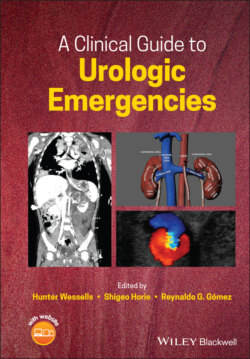Читать книгу A Clinical Guide to Urologic Emergencies - Группа авторов - Страница 28
Urinary Extravasation and Perinephric Abscess
ОглавлениеAUA guidelines recommend that clinicians perform urinary drainage in the presence of complications such as enlarging urinoma, fever, increasing pain, ileus, fistula, or infection [34].
Renal injuries with urinary extravasation at initial presentation can for the most part be managed conservatively given the high rates (90%) of spontaneous resolution, although repeat imaging is intended to evaluate for persistent leaks, urinomas, or perinephric abscesses that require additional intervention such as stenting or percutaneous drainage [3046–48, 98]. Patients with devitalized renal parenchyma in conjunction with urinary extravasation tend to have increased morbidity and may require more aggressive management [80,96–98]. Furthermore, patients with concomitant injuries, such as pancreatic or colonic injuries, may also have a higher likelihood of developing complications [25,99–101].
In practice, approximately 29% of patients with high‐grade renal trauma undergo ureteral stent placement [102]. To date, there are no standard guidelines on duration of stent and Foley placement for high‐grade renal trauma. In a single center series, an indwelling stent for six to eight weeks was associated with favorable outcomes [103]. Generally, maintaining a Foley catheter while a stent is in place helps with healing by preventing antegrade reflux of urine to the kidney, minimizing pressure in the collecting system, and enhancing urinoma drainage. Percutaneous drains may be necessary in cases of increasing urinoma size, complexity, and/or infection [34].
